Lunar New Year 2023 is a holiday filled with ancient customs, delicious food, and beautiful decorations. Also known as Spring Festival or the Chinese New Year, it is the biggest holiday in China. However, billions across the world celebrate it—both within pockets of communities of Chinese descent, in certain indigenous groups, and in other Asian countries like Thailand, South Korea, Japan, and Vietnam. We’re thrilled to share what we know of this symbolic festival.
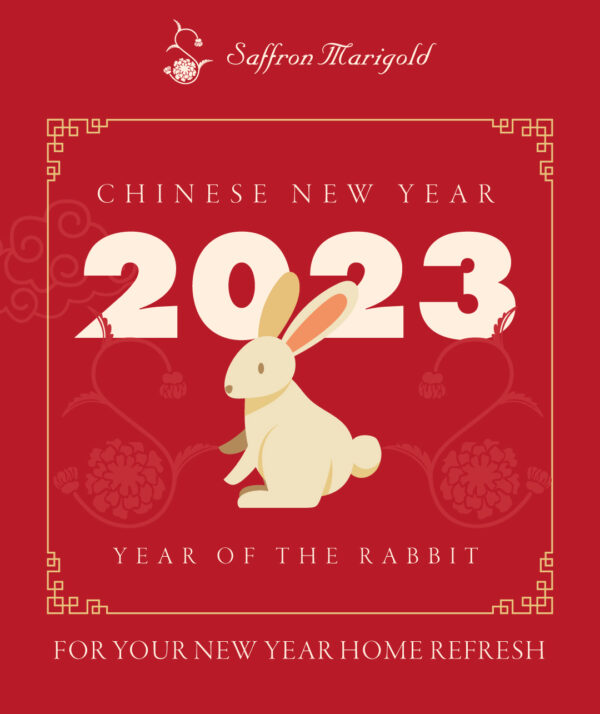
What is the Lunar New Year celebrating?
Lunar New Year marks the first day of the lunar (aka lunisolar) calendar year, which is based on the moon’s cycles. It is a sacred time to honor ancestors, reunite with families, and look forward to the new year. In ancient times, the Lunar New Year was a significant event to farmers who looked to the sky for clues when to sow their crops.
One of the most prevalent legends associated with Chinese New Year is that a beast called Nian used to eat crops, livestock, and people on new year’s eve. To keep Nian at bay, people laid out food in front of their doors.
Then someone discovered that Nian was scared of loud noises and the color red. People began to use crackled bamboo (now firecrackers), red scrolls, and red lanterns to prevent Nian from coming inside their homes.
Today, these legends are still widely told, but the festival’s meaning has shifted to focus on family reunions, lion dances, and gift-giving.
Is Lunar New Year the same date every year?
No. Lunar New Year marks the first day of the lunar (aka lunisolar) calendar year, which is based on the moon’s cycles. It begins on the second new moon sometime between January 21 and February 20. It ends on the full moon 15 days later. In 2023, the Lunar New Year begins on January 22 and ends on February 5.
How long is the Lunar New Year?
It is 15 days from beginning to end. Mainland China grants its citizens seven days off, and in Korea, many people get three days off. Many people who live abroad make the trip back home to spend time with family and friends.
Where is Lunar New Year celebrated?
Spring Festival is celebrated across Asia and in many countries with large Chinese or Asian communities. Countries influenced by Chinese culture liike Korea, Vietnam, Philippines, Tibet, Malaysia, Indonesia, Mongolia, Singapore, and Thailand also participate in the festivities. Additionally, the Nisga’a people of Indigenous Canada also celebrate this holiday through their own traditions.
Common Lunar New Year greetings and wishes
Here are some ways to bring a smile to someone’s face on Lunar New Year.
Standard Lunar New Year greetings
You can’t go wrong with a standard greeting, no matter who you are addressing.
Xīn nián kuài lè (Chinese)
Chúc mừng năm mới (Vietnamese)
Happy Lunar New Year!
Chinese New Year wishes
These wishes can be modified to be more polite or informal, depending on who you are greeting.
Gōng xǐ fā cái or Wishing you prosperity and wealth (Chinese)
새해 복 많이 받으세요 (saehae bok mani badeuseyo) or I wish you good luck in the new year (Korean)
Shēn tǐ jiàn kāng or Wishing you good health (Chinese
Lóng mǎ jīng shén (Wishing you lots of energy and good spirit”
May you be happy, healthy, and prosperous in this coming year and always.
May your year be full of happy new memories.
Wishing you all the luck in this Lunar New Year.
Wishing that you stay full of love, hope, and inspiration throughout this New Year.
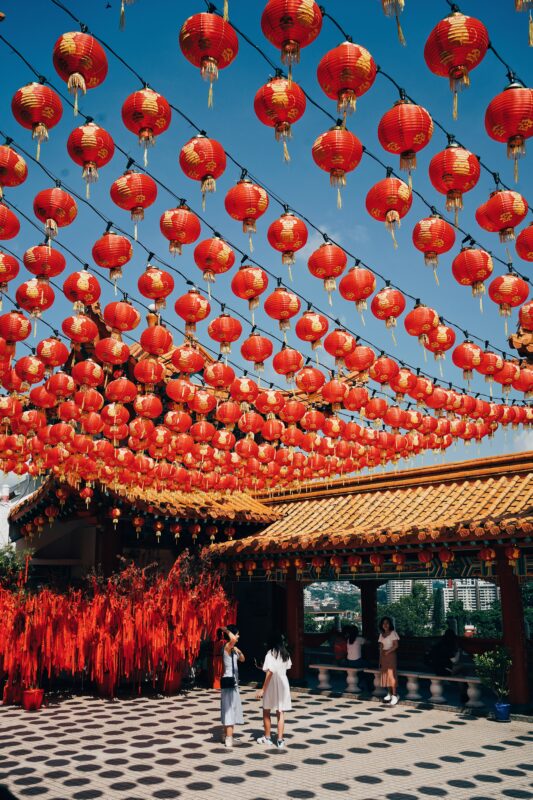
Lunar New Year traditions and celebrations
Traditionally, the Lunar New Year is celebrated over 15 days. Many people might only celebrate the first few and last days of the festival due to work and lesser emphasis on customs. The names correlate to various Chinese gods or creatures present in the Chinese Zodiac.
Lunar New Year’s Eve: Family Reunion Dinner
This day is the most important of all. A huge family reunion dinner is held with lots of food, red decorations, and red envelopes with cash. Most stay up until midnight to welcome the new year, watch fireworks, set off firecrackers, and pay respects to ancestors.
Day 1: Birthday of Chicken, Visiting Family
The oldest members of a family are visited by the younger members. Visitors greet the hosts with small gifts, and hosts lay out a delectable arrangement of sweets and tea. Edible treats are arranged on a round or octagon-shaped tray known as the Tray of Togetherness.
Eight is a lucky number in Chinese culture, and most of the time, sweets will be served in multiples of eight.
Outside, lion dances may be performed.
Day 2: Birthday of Dog
This day is dedicated to visiting parents, particularly for married women. Pets and many stray animals are fed, and people eat ingot-shaped wontons to bring in luck in the new year.
Day 3: Birthday of Pig
If a family member has passed away in the last three years, they will not visit other family members on this day. Instead, they will visit their family’s grave. Many stores keep shut until the fifth day to avoid lost spirits believed to be present around the world.
Day 4: Birthday of Sheep
Most people continue to stay home to rest.
Day 5: Birthday of Ox, Cattle
The God of Wealth celebrates their birthday on this day, and many people eat dumplings to celebrate.
Day 6: Birthday of Horse
People visit temples, relatives, and friends.
Day 7: Birthday of Men
Renri is the seventh day of the first lunar month and is believed to be the birthday of humanity. People cook seven types of vegetables and rice
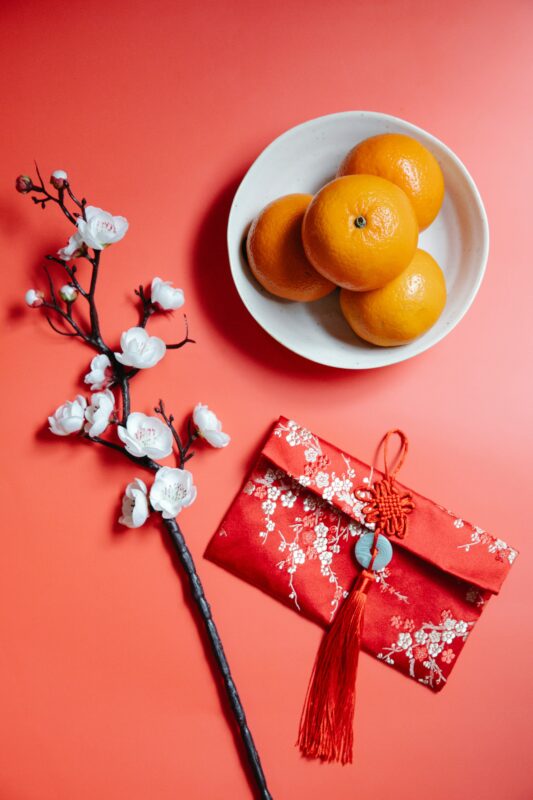
Day 8: Second Family Reunion Dinner
During midnight, people pray to the Jade Emperor.
Day 9: Birthday of the Jade Emperor
The Jade Emperor is also called the God of Heaven and Emperor of the Universe in the Taoist faith. On this special day, people prepare “three bundles of long noodle, three tea cups with green tea, five different kinds of fruit and six different kinds of dry vegetables.”
Firecrackers are set off, and many people pray for luck, health, or love at temples.
Day 10-12: Time with Family and Friends
Festivities and feasting continue!
Day 13: Eating Cleansing Foods
Throughout the Spring Festival, people fill up with sweets and comfort foods. The thirteenth day is reserved for eating vegetarian dishes and other ‘cleaner’ foods to help cleanse the body. Many people begin to procure lantern decorations on this day.
Day 14: Lantern Decoration Day
Prepare for the last day of the Chinese New Year by cooking and decorating lanterns. Dragon and lion dances may be performed.
Day 15: Last Day of the Lunar New Year, Lantern Festival
Also referred to as the first night of the full moon, people will take their decorated red lanterns to temples , display them at fairs or at home, or let them fly away. Symbolically, bringing the lit lanterns to temples helps lost spirits find their way home. Traditionally, lanterns bear a riddle that a person must solve to get the lantern.
On this day, families hold one last reunion dinner. Sweet dumplings called yuanxiao are eaten.
Festive Chinese New Year decorations and ideas
Two things you need for traditional Lunar New Year decor: red and luck-bringing items. Cleaning the house before the new year is a huge custom thought to eliminate any bad luck from the previous year and invite prosperity. Red, a lucky color, is incorporated not just to usher in wealth, but to scare off evil spirits that may be out and about.
Red living room decor
Make sure your living room is decked out in red—this is where most of the partying and catching up will happen. Hang up the Ruby Kilim curtain panel, and accessorize the sofa with red throw pillow covers and a Ruby Kilim quilt.
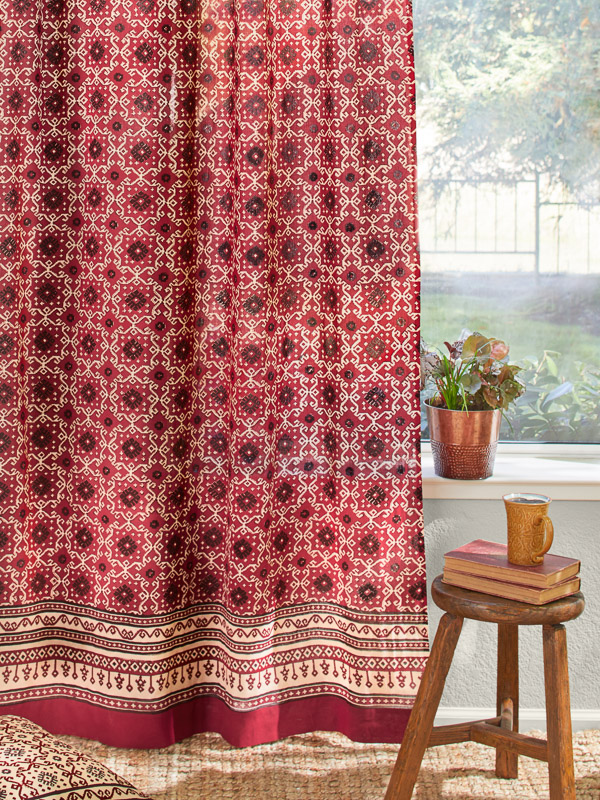
Chinese lanterns and door couplets (banners)
Red lanterns are associated with joy, good luck, and energy. On Lantern Day, many people will string these up at home or light them up at the temple.
Couplets or banners are hung in pairs by windows and doors. They bear new year greetings, auspicious numbers, and good luck wishes for the new year.
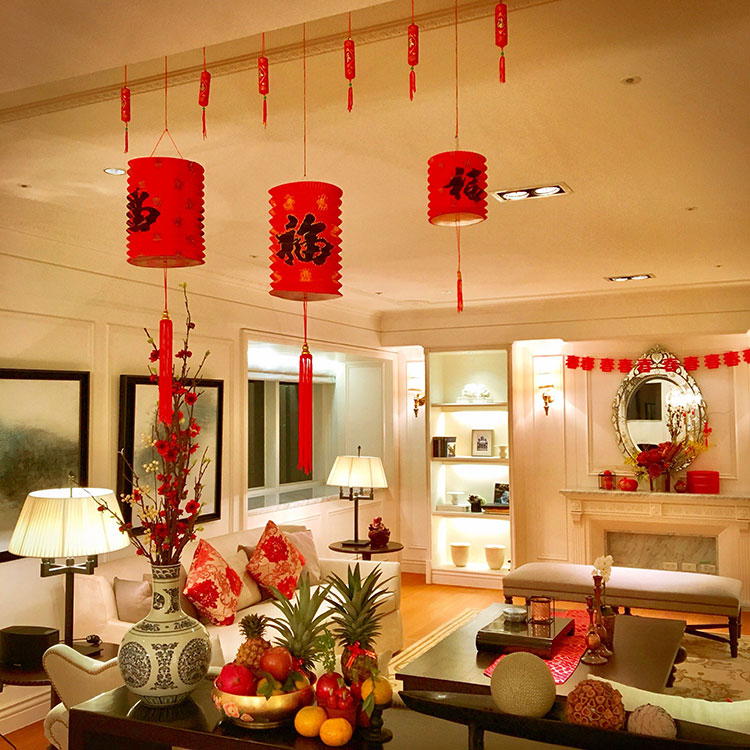
Khmer Times
Red Lanterns
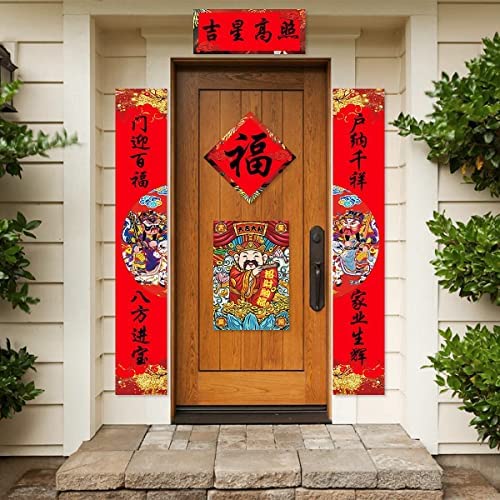
Amazon
Chinese New Year Decoration
Red envelopes/packets
Red packets are filled with money, but they can also be used to decorate trees or hung on a string across a wall.
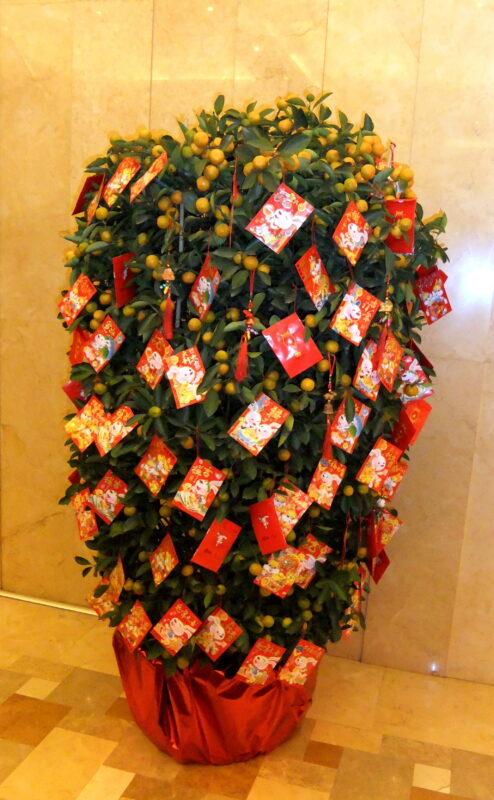
Chinese knots or tassels
Also known as Chinese decorative knots, these charms are thought to scare off evil spirits. They represent balance, longevity, and good fortune.
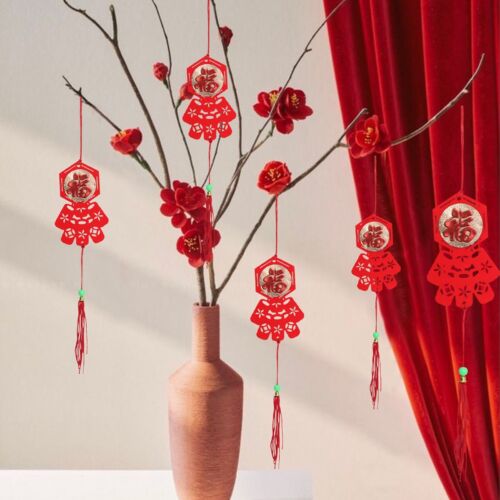
Paper cuttings
Cut paper, stuck onto walls and windows during the new year, symbolizes good luck and happiness. Popular patterns include flowers, chinese symbols, animals, and the character ‘fu.’ It means good fortune, happiness, and blessings, and many people stick it onto walls, doors, and windows upside-down to represent good luck pouring into one’s life.
Cutting paper is a popular activity for kids and adults. Simple designs use scissors, but intricate patterns are traditionally cut with a knife. If you prefer, pre-made papers are also widely available online.
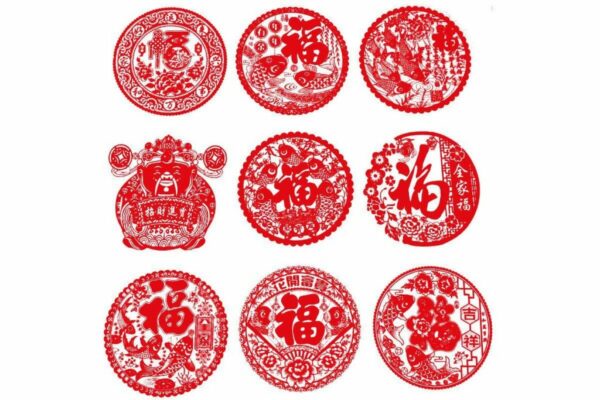
Orange, kumquat, or mandarin trees
Citrus trees are thought to bring wealth and good luck into the home. Some people give away citrus fruits in pairs on new year’s day. Smaller trees may be given as gifts, especially to business contacts.
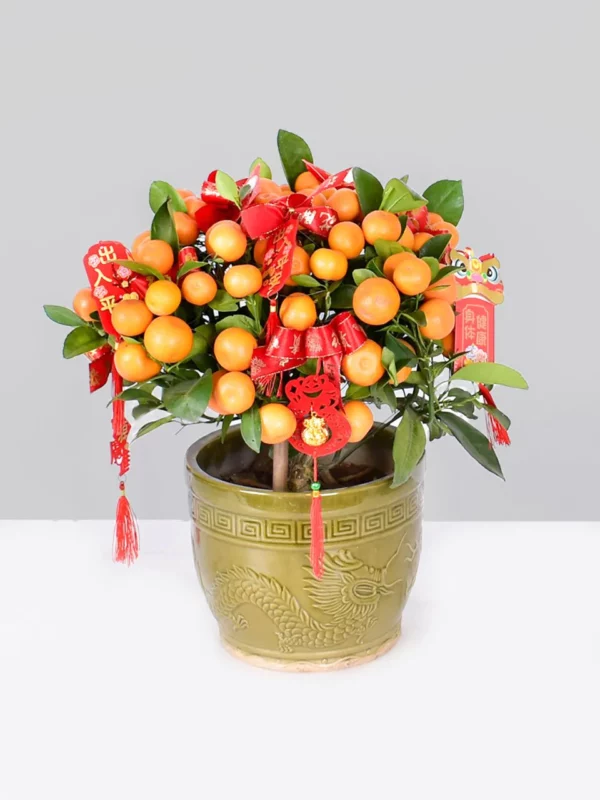
Plum, cherry, or orchid blossoms
Flowers are a classic Chinese New Year decor.
- Orchids symbolize purity and fertility.
- Plum blossoms symbolize courage, endurance, and perseverance.
- Cherry blossoms represent renewal and the coming of spring.
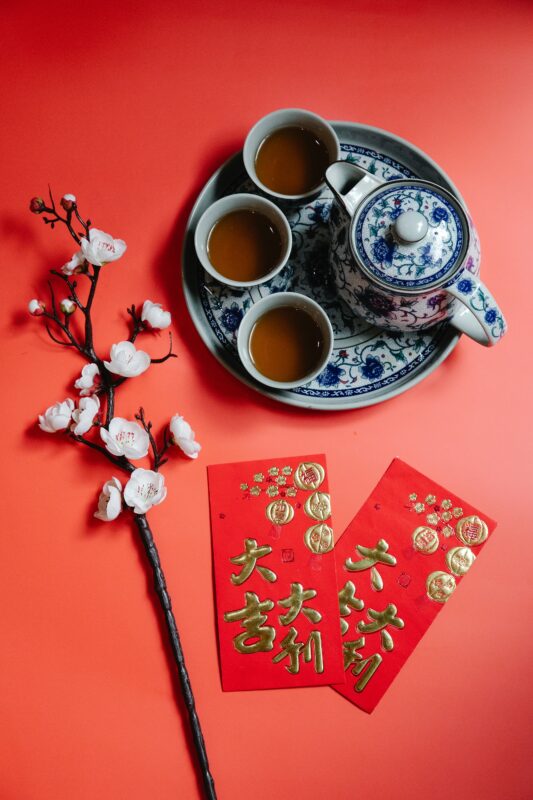
Red bedroom decor
Red is thought to bring good luck and ward off evil or lost spirits. Try Ruby Kilim bedding to usher in prosperity for the new year!
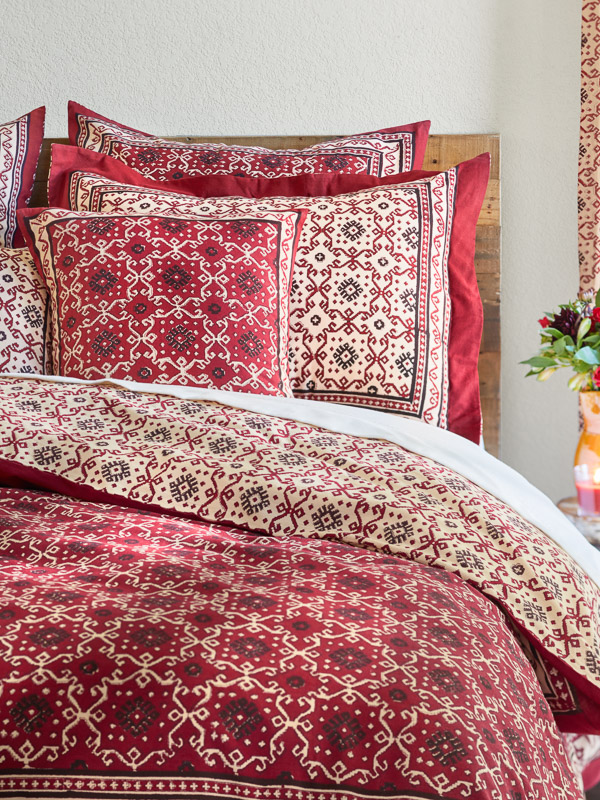
Festive family reunion dinner table
Family reunion dinners are the most important events in the Chinese New Year festivities. Common foods include fish (two), dumplings, spring rolls, and chicken (two). Set your reunion meals with Spice Route, a vibrant red-orange print that will surely match the merry atmosphere.
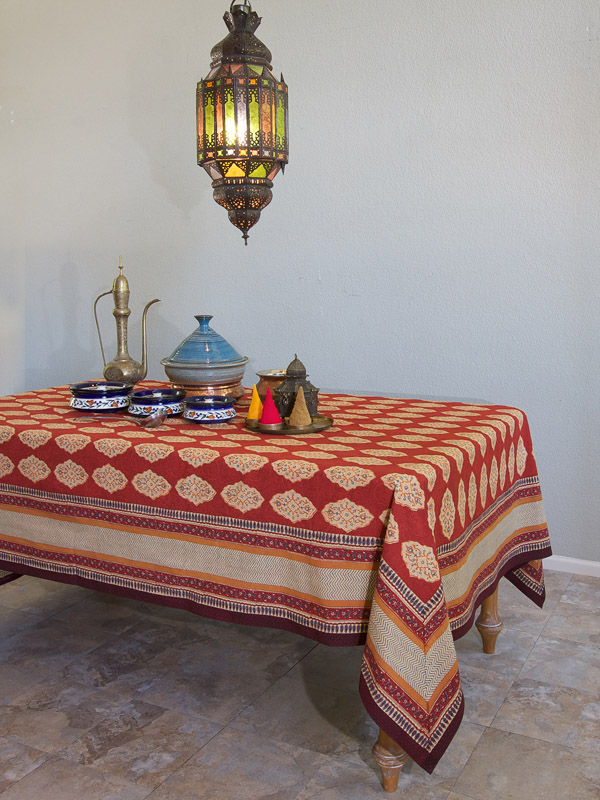
Looking for more ways to decorate with red? Take a look at our special design guide on how to prepare a red guest bedroom for the holidays.

